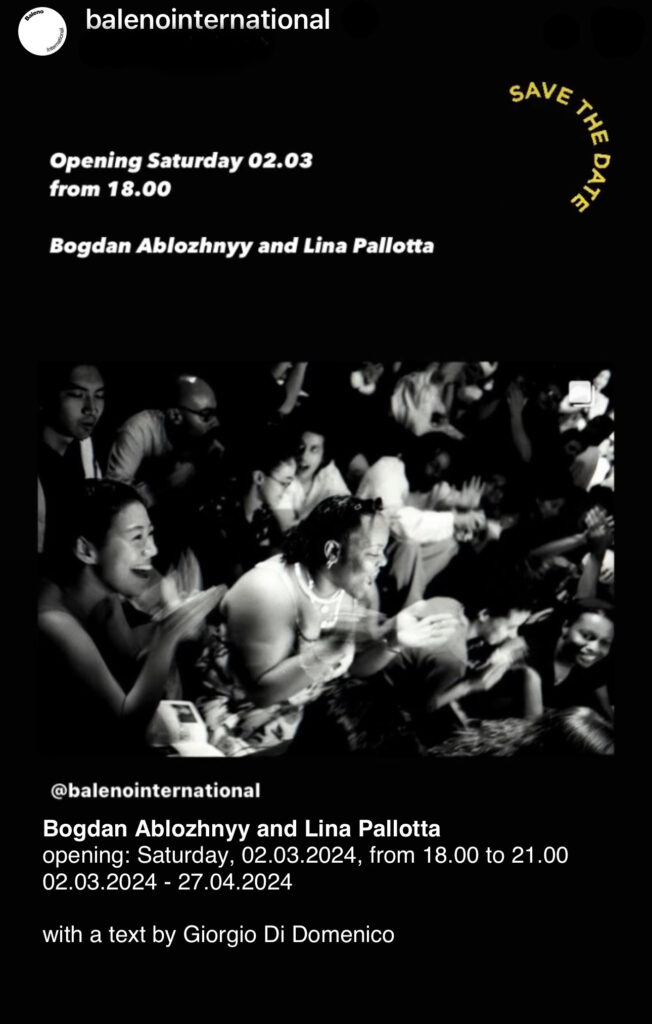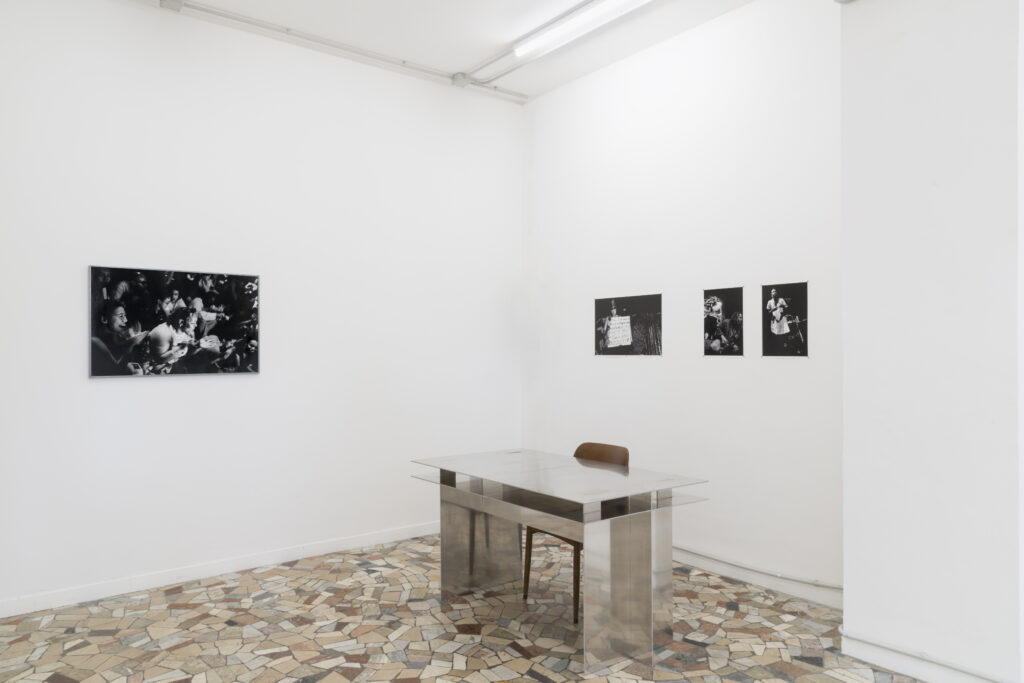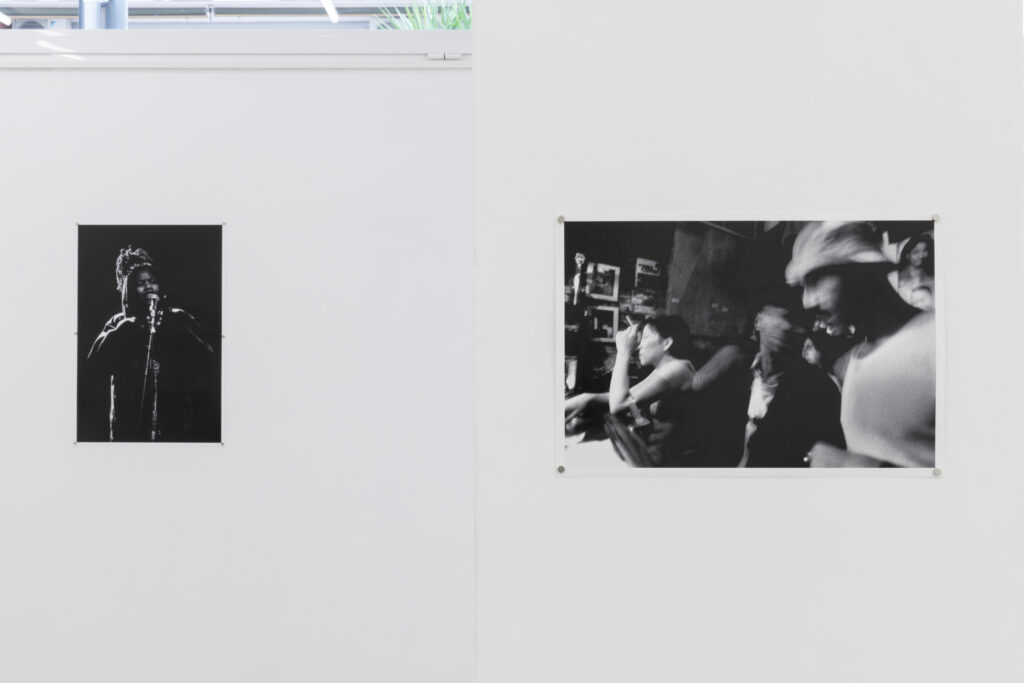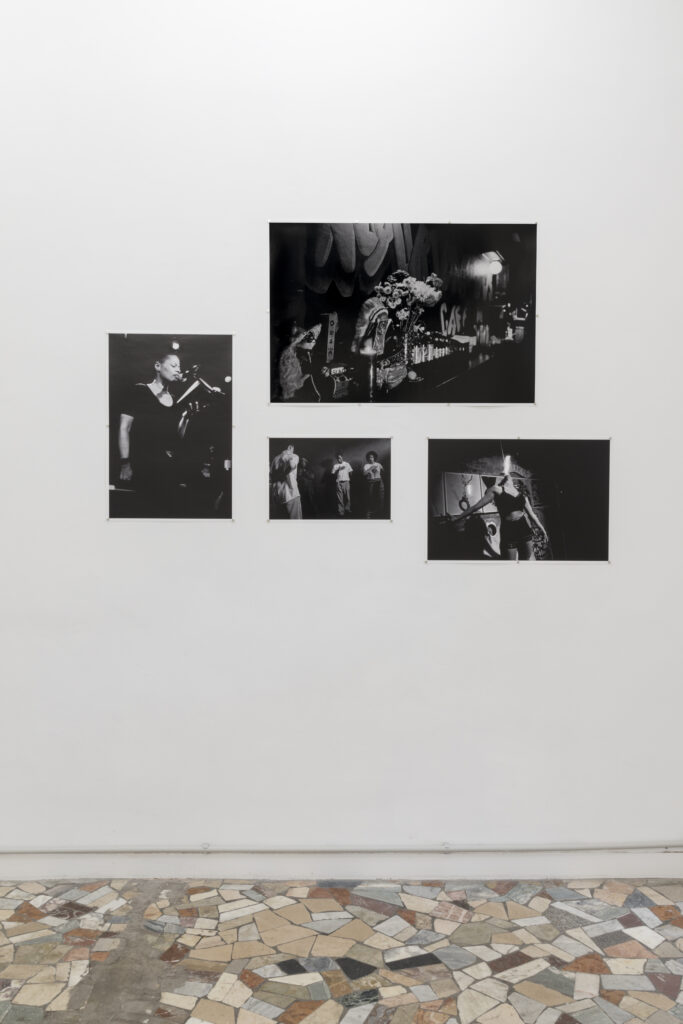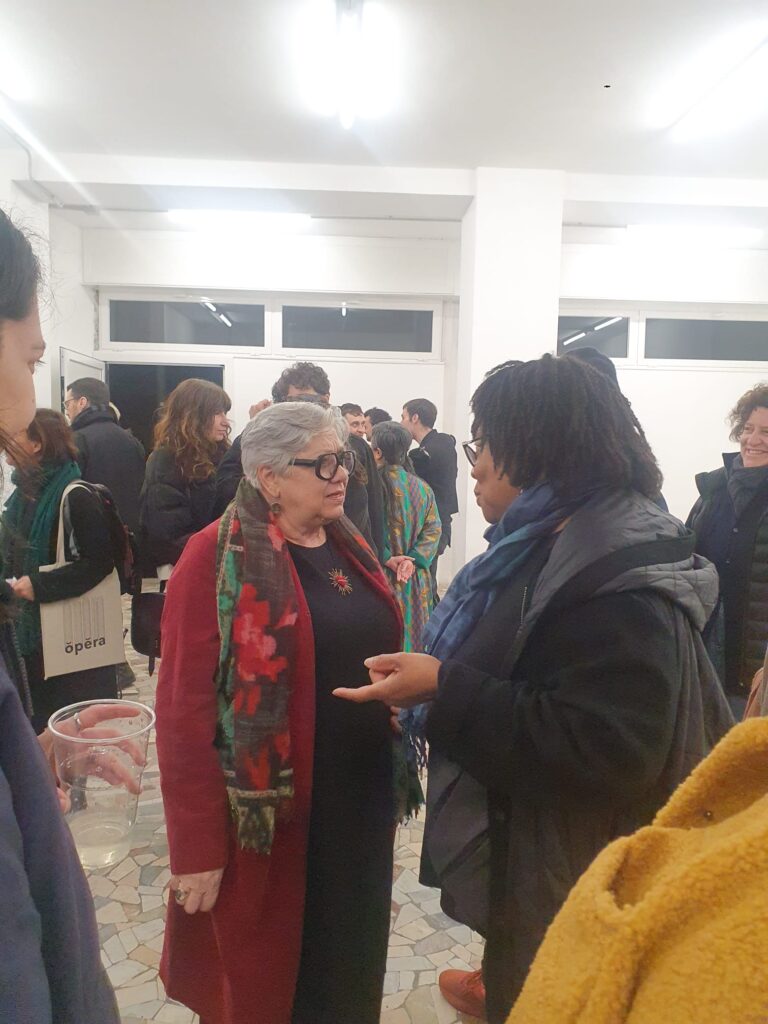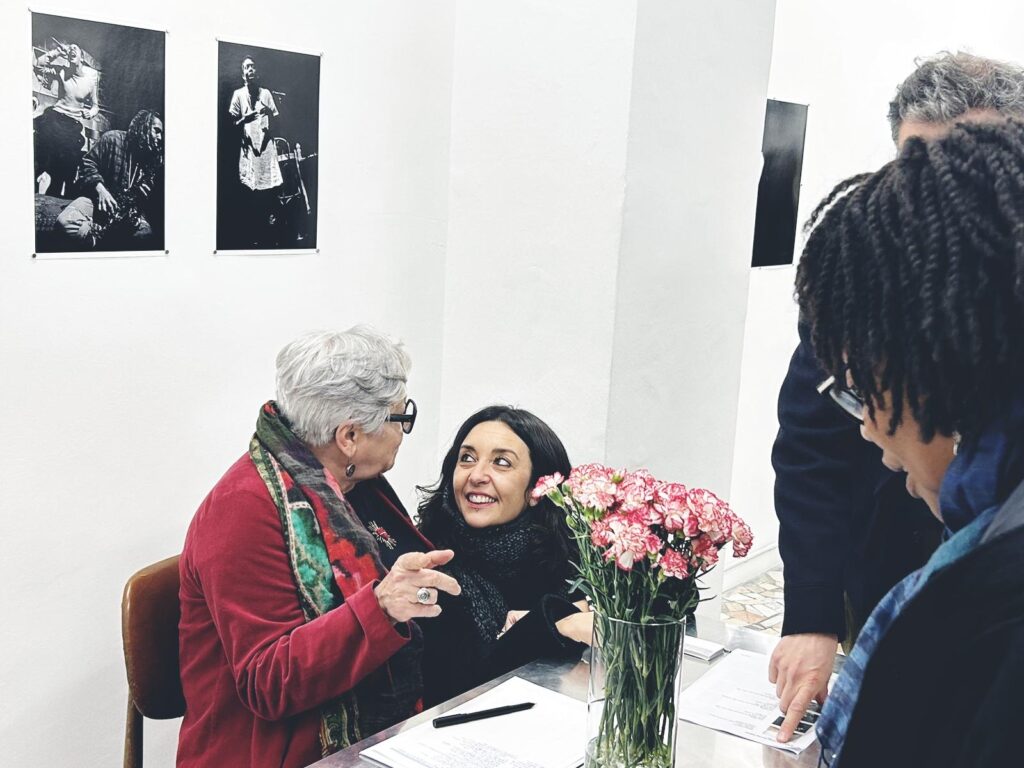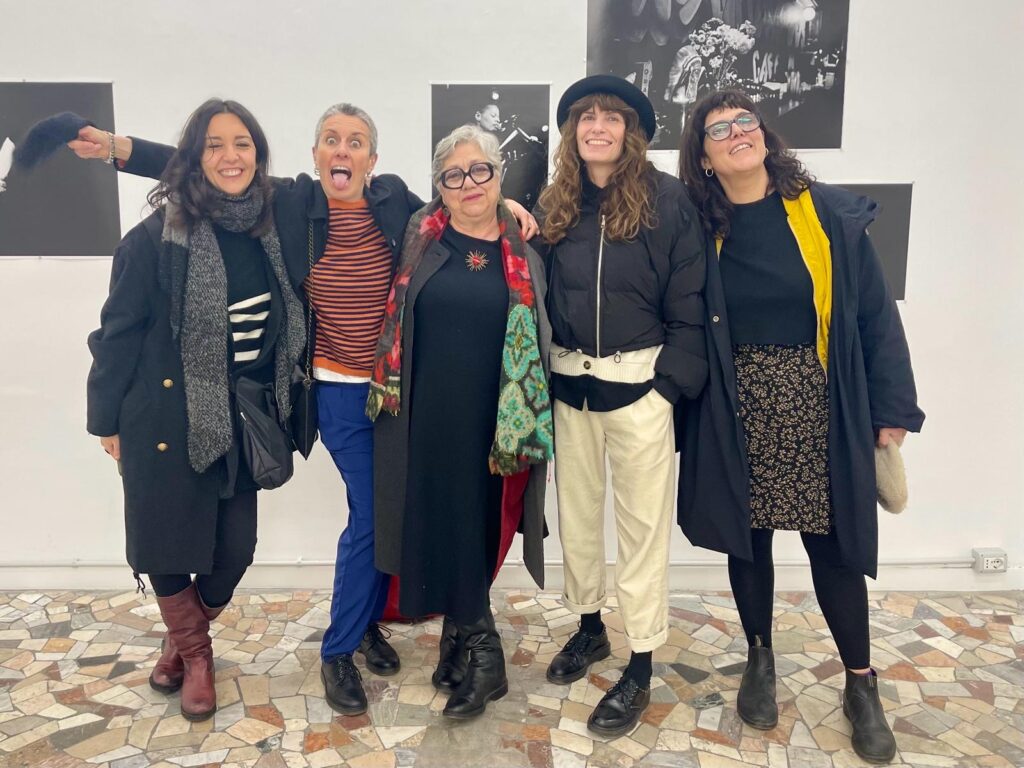Baleno International Tongue on Flames
Bogdan Ablozhnyy and Lina Pallotta
from 02.03.2024 to 12.05.2024
It Is All Voice
In 1992, Lina Pallotta began frequenting the East Village clubs where the New York slam scene used to gather. On Wednesdays and Fridays, the weekly appointment for contests and open mic nights was at the Nuyorican Poets Café. Faced with the poetic word performed, embodied, and intertwined with music, Pallotta began to take photographs. She thus became part of an alternative creative community, all gathered around the power of words. These were people driven by social and identity politics, the same scene that Steve Cannon was bringing together around his legendary magazine, A Gathering of The Tribes.
Pallotta pictures Cannon at the bar, next to Reg E. Gaines and a woman smoking. Their gestures are quick, their faces blurred, their words sharp. Perhaps ‘the blind guy’ has just shouted his iconic exhortation to a poet on stage: ‘Read the goddamned poem!’ [1] In the dark backgrounds and sharp lighting of the images captured by Pallotta, the words spoken by the authors become visual. On stage, as in the photographs, debutants alternate with established poets, musicians with militants: Pedro Pietri with Aussie, Janice Erlbaum with Nadine Mozon, and Sapphire with Tish Benson. The relationship with the audience nourishes the spoken word. Glances complicate the performance. The interaction ensures effective communication. The spirited gaze of the poets responds to the ecstatic eyes of the crowd.
The voice connects everyone, and the camera captures everything.
One evening in 1994, the Coney Island freaks arrive at the Nuyorican. The fire-eater spits her snaking tongue of fire from the stage towards the audience. Pallotta captures the moment and with the moment analogy. She decides to name her series of photographs of slam poets, which has been running for a few years now, Tongue on Flames, a variation on the title of a 1990 David Wojnarowicz retrospective. In 1981, the artist, a protagonist of the East Village creative scene who died of AIDS in 1992, had dreamt of filming a fire: ‘I was seeing all this through the viewfinder of the movie camera and recording it. The colours of the flames and the light reflecting against the white wall of the garage were burning first bright oranges and reds, then these phosphorescent blues.’ [2]
Likewise, towards the end of Transparent Things, a 1972 Nabokov novel, the protagonist dreams of a fire: ‘Flames spurted all around and whatever one saw came through scarlet strips of vitreous plastic.’ [3] The Walk (2023) is a sculpture composed of three parallel, supposedly endless rolls of transparent polyester, fabric, and reflective foil. The materials originate from a wall, roll across the floor, and reach the opposite wall. Introducing this work, Bogdan Ablozhnyy evoked another passage from the same Nabokov novel: ‘When we concentrate on a material object, whatever its situation, the very act of attention may lead to our involuntarily sinking into the history of that object. Novices must learn to skim over matter if they want matter to stay at the exact level of the moment. Transparent things, through which the past shines!’ [4]
Ablozhnyy, as Pallotta, explores the documentary potential of photography. For him it is a continuous process of analysis that operates in his life as an artist, inside and outside the studio, as a carnet to note formal complexities, as a documentary support for the analysis of sculptures or installations, or as an output and considered as a final work. The transparent surfaces of The Walk can function as allegories of the photographic act: through the transparent foils, not only the past shines, but also the present fixes. The very presence of the work, and thus of its materials, testifies to the availability and actual subsistence of the space that hosts it: the surface between the two gallery walls.The Walk is a score and can be extended or reduced according to the spacious conditions it is exhibited. The sculpture marks the space it inhabits in the same way a pause in musical notation marks a passage of time.
A few days ago, Ablozhnyy spoke to me about the practices of Laurie Parsons, Marc Camille Chaimowicz, and the early Karen Kilimnik. When in 1990 Parsons had left empty the spaces of her first solo show at the Lorence-Monk Gallery in New York – a mile, twenty-minute walk from the Nuyorican – one reviewer hinted at the implicit invitation of that radical move: ‘Parsons invites us to make the leap and walk on water.’[5] The Walk, on the contrary, invites the viewer not to make that leap, to imagine the walk on water only from a distance, pushing up to the edge of the transparencies with their feet, and then surveying them only with their gaze.
The title of Ablozhnyy’s sculpture is a reference to a 1917 short story by Robert Walser, The Walk. When in 1982 Susan Sontag was asked to introduce the English edition of the story, she insisted on the role of the author’s voice: ‘His work plays with the depressive’s appalled vision of endlessness: it is all voice – musing, conversing, rambling, running on.’ [6] Ablozhnyy’s transparent scrolls, concrete ‘visions of endlessness,’ can maybe fuel the reading of Pallotta’s photographs, in which, as in Walser, ‘it is all voice.’
Giorgio Di Domenico
[1] Melanie Maria Goodreaux: ‘Gathered Tribes: The Legacy of Steve Cannon’, Ursula, November 13, 2019.
[2] David Wojnarowicz, In the Shadow of the American Dream, New York 1998.
[3] Vladimir Nabokov, Transparent Things, New York 1972, ch. 20.
[4] Ivi, ch. 1.
[5] Jan Avgikos: ‘Laurie Parsons, Lorence Monk Gallery’, Artforum, XXIX, 2, October 1990, p. 164.
[6] Susan Sontag: ‘Walser’s Voice’, in Robert Walser, Selected Stories, New York 1982, p. viii.
Baleno InternationaI
Via Montecuccoli 11G, Rome, Italy
https://baleno.international/
email info@baleno.international
